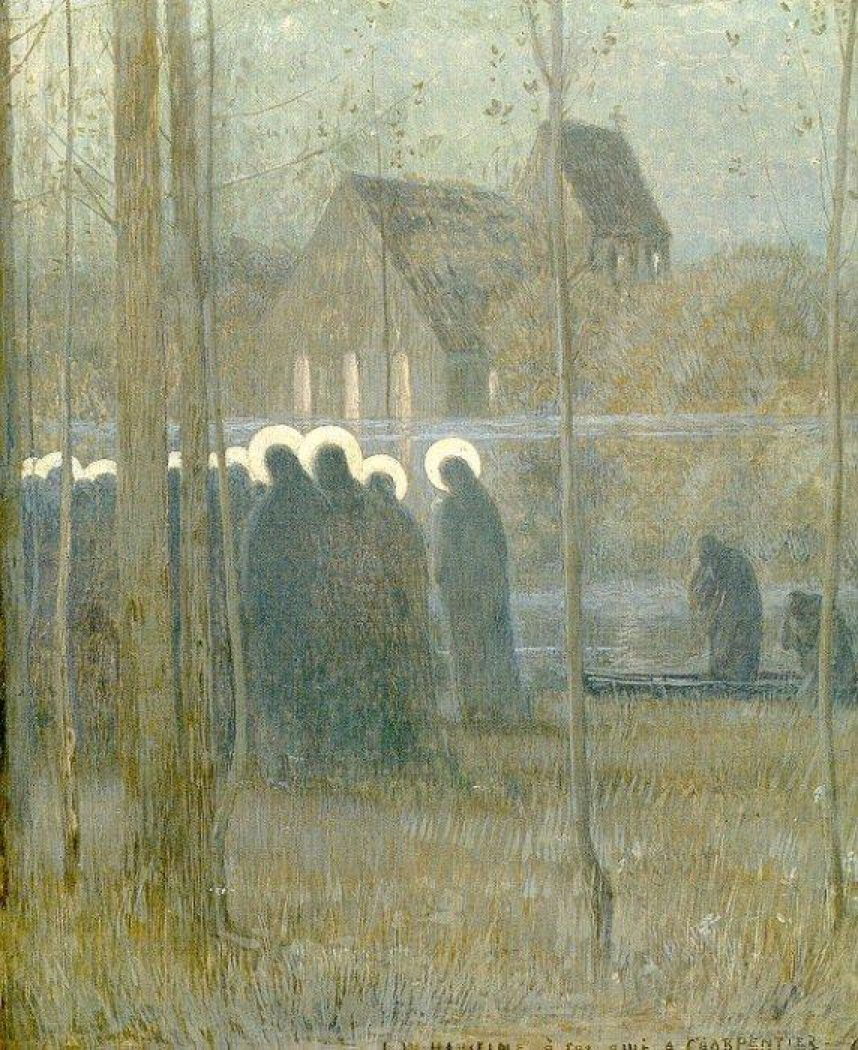In the first of this pair of articles about the paintings and career of Louis Welden Hawkins (1849–1910), I showed examples of his early Naturalist work, and his transition to Symbolism in the early 1890s.

Although undated, I suspect that Hawkins’ wonderful painting of Clytie dates from the early 1890s too, with this distinctive confluence of Impressionist handling of colour coupled with Symbolist motifs.
Clytie’s story is told in Ovid’s Metamorphoses. She had fallen in love with the Sun, and spread the tale of Venus and Mars being caught making love and being trapped by Vulcan’s net. She pined in vain for the Sun’s attention, sitting outside for nine days and nights without food or drink. As a result, she became rooted in the soil and was transformed into the heliotrope or sunflower, seen here behind her back.

The Procession of Souls (1893) was dedicated to the successful sculptor Alexandre Charpentier, who was a close friend. It shows a group of figures with haloes walking slowly along a riverbank, as two cloaked boatmen wait in their small boat on the river – suggestive of Charon on the River Styx. On the opposite bank is a chapel, its windows lit up in the gloom of the half light.

Back in 1888, Hawkins had lived for a while with Camille Pelletan, a radical socialist politician, and he continued to move in radical circles. His Portrait of Séverine (1895) shows a popular journalist, who was then at the height of her fame. Séverine’s original name was Caroline Rémy (1855-1929), and she was a famous defender of humanitarian causes. During the First World War, she sided with anarchists and protested against the fighting.
Hawkins made this frame himself. On its left are olive branches and the inscription PAX (peace), and on the right are ears of wheat and the inscription PANIS (bread). This work was shown at the Salon Nationale in 1895, where it was greatly admired.
In the mid-1890s, Hawkins made friends with the Symbolist writers Paul Adam and Jean Lorrain, and with Stéphane Mallarmé, and through his soirées met Puvis de Chavannes, Odilon Redon, and Claude Monet. Hawkins’ work remained popular among those of the Symbolist movement, with its controversial leader Joséphin Péladan, and at its annual Salon de la Rose + Croix.

Several of Hawkins’ paintings were turned into popular prints, although I have been unable to trace any original for Readers (1897), or evidence that Hawkins himself might have engraved it.

Le Foyer or Home from 1899 is another good example of his ostensibly simple motifs which become charged with mystery thanks to his skilful use of light.
That same year, his style changed yet again, with the use of dazzling chroma.

The Eiffel Tower as Seen from The Trocadero (c 1899) is one of a pair of views which Hawkins painted while the pavilion for the 1900 Exposition Universelle was being constructed, here seen in the distance behind the Eiffel Tower. In the foreground is the sculpture Asia, by Alexandre Falguière (1831-1900), which decorated the old Palais du Trocadero, which had been built for the Exposition of 1878.

At the turn of the century, in an effort to improve his family’s income, Hawkins turned to making masks and fans in fashionable Art Nouveau style. These proved most popular at the Exposition of 1900, and are exemplified by Mask (1895-1905) above, which was drawn in black chalk and pencil, and Fan (1905), below, which was painted in gouache.


The Sphinx and the Chimera (1904-06) is an extraordinary painting which draws from Hawkins’ own paintings of women, such as Les Auréoles from the previous article, with influences from Moreau and Khnopff. It’s hard to distinguish the Sphinx with its radiantly beautiful womanly face and sculpted wings, from the grotesque head and body of the chimera beneath.

A Veil is a chalk drawing which shows Hawkins developing themes which are reminiscent of Odilon Redon and of pastels by Fernand Khnopff, such as his Voile series. Although it has been claimed to date from around 1890, it seems more likely that it was made in Hawkins’ final year or two, perhaps as late as 1909.
In 1905, Hawkins’ arts circles in Paris collapsed, and he and his family retired to Brittany, where he spent his remaining five years painting realist landscapes. He still returned to the city to paint watercolour views, and died there in 1910 after suffering a heart attack. His first solo exhibition didn’t take place until 1993, at the Van Gogh Museum.
Reference
Lucas Bonekamp (1993) Louis Welden Hawkins, 1849-1910, Van Gogh Museum. ISBN 978 90 6630 442 0.

